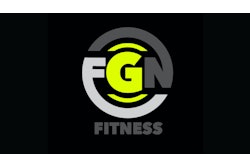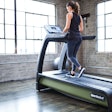The Pilates Chair is smaller than the Reformer, and is versatile in the number of exercises that can be performed on it. Find out the basics for implementing a Pilates Chair class in your facility.
The latest Sporting Goods Manufacturers Association (SGMA) research indicates that participation in Pilates has grown from 1.7 million in 2000 to 10.3 million people in North America in 2005 - a tremendous increase of more than 500 percent. Pilates programming in fitness centers has also shown a corresponding growth pattern. It is well known that the exercise method has become a chief generator of non-dues revenue at fitness facilities throughout the world.
Until recently, Pilates programming options within fitness centers have centered on mat or Reformer work. However, the Pilates Chair is starting to make a loud noise in the fitness world. Pilates originator Joe Pilates designed his original chair (he called it the Wunda Chair) nearly a century ago. The traditional Chair is basically a box with a padded seat and a foot pedal with springs attached to provide resistance. Users can sit, stand, kneel or lie on this multipurpose apparatus, developing upper-body strength, stabilizing the torso, and performing a number of lower-body and foot exercises.
Over the years, the Pilates Chair has continued to evolve. Many models now have a split pedal, which greatly increases the number of exercises that can be performed. The latest innovation on the Chair includes attachments for resistance bands or tubes. This gives the Pilates Chair the same full-body workout capabilities as a Reformer, but uses a fraction of the space. The Chair's space-saving size holds enormous appeal for fitness centers.
Meet the expert
Nora St. John, education director of Balanced Body University, and owner of Turning Point Studios, Walnut Creek, Calif.Compact size is key
Nora St. John has worked with the Pilates Chair for years. Because of its size and versatility, St. John views the Pilates Chair as perfect for fitness centers looking to implement an equipment-based Pilates program. "Most Chairs stand a little over 2 feet tall, with a physical footprint of approximately 5 square feet. This is key for clubs with limited room," says St. John. "In a 20-by-20-foot space, you can fit 10 Chairs with room to spare. And, many are lightweight and stackable, so you can store them easily. ... They're just much easier than Reformers to move around and store."Finding instructors: Your current staff will do fine
What's the first thing a fitness center should do when implementing a Pilates Chair program? St. John says that, as with every exercise program, it initially comes down to getting good instructors. In the case of finding a Pilates instructor, you have two choices: hire externally or train existing staff. The latter is usually preferred, as existing staff are familiar with your facility's philosophy and membership dynamics. But, this can be a time-consuming endeavor.St. John points out, however, that implementing a Chair program is much easier than a Reformer program. "The Pilates Chair, especially with resistance bands, is very similar in vocabulary to what your existing personal trainers or group exercise teachers are already using," she says. "A 12-hour training course gives them what they need to know to start a Chair class. They can then continue their education as their schedule permits. It's not like learning the Reformer, which is a much more complex piece of equipment, with many nuances and modifications to learn. If you have existing Pilates staff, learning to teach Pilates Chair classes is a small addition to what they already know. If you don't, it is a great entry point for your personal trainers and group exercise instructors to get into teaching Pilates," says St. John.
To find Pilates Chair training, you may not need to look further than your equipment supplier. Most Pilates equipment manufacturers offer instructor curriculum that include Pilates Chair training. Some include the option to train your staff onsite at your facility.
Pilates SuppliersLooking to start a Pilates Chair class? Here are the major Pilates equipment manufacturers. Each has a version of the Pilates Chair, and corresponding training programs. Balanced Body www.pilates.com Balanced Body's Pilates Chair offerings include the Combo Chair, EXO Chair and Wunda Chair. Peak Pilates www.peakpilates.com Peak's Pilates Chair offerings include the MVe Fitness Chair, High/Low Combination Chair, Low Chair and the Wunda Chair. Stott Pilates www.stottpilates.com Stott Pilates Chair offering includes the Split-Pedal Stability Chair. |
||
Build member interest
Once your instructors are hired/trained, you'll need to create an effective demo for your Chair program. Demos are crucial for building member interest, and getting sign-ups for a class. This is especially true for classes that require members to pay an additional fee."The nice thing about the Chair is that you can do a very effective demo in 15 or 20 minutes, since it doesn't have the number of logistical preparations required during a Reformer demo (spring changes, body position changes, cuing, etc.)," says St. John. And, due to its compact size, you can include three or four people at a time instead of just one or two on a larger piece of equipment."
The key to creating a good demo is choosing exercises that transition easily from one to another, and making it challenging but not overly difficult. "The Chair is a challenging strength tool," says St. John, "particularly if it has resistance bands. Your members will feel it even in the demo, so keep that in mind."
Have members sign up for the free demo class, and hold them at times when lots of other members will be around to see it. Promote the new class internally, especially to your members who currently take other group classes.
Starting your Chair classes
St. John recommends that instructors new to the Chair begin with four or five participants in a class. That number can grow to 12 as the instructor gains more experience.From an exercise standpoint, the best way to start your class is with basic fitness work - like sitting in the Chair and performing leg pumps, or standing in front of the Chair and performing biceps curls or basic chest presses. These are exercises everybody has done, and it gets them familiar with the apparatus.
"Instructors should start with basic fitness, and then use the additional benefits of the chair - like the split pedal or the resistance bands - to create a more challenging workout," says St. John. "You can do this by adding more complex balance and coordination exercises, or by combining exercises for different parts of the body, like adding arm work to your lower-body exercises."
Keeping it fresh
A key element of any successful class is keeping the program fresh. This is even more critical when you charge an additional fee for the class. Pilates instructors too often roll out the same exercises every week, or don't diversify enough to keep members excited. This can lead to declining attendance - and revenue."One of the main directives of any training program is teaching instructors to put together a well-rounded class, with exercises that offer a little bit of everything," says St. John. "This includes functional sequences, arm sequences, rotation sequences, leg sequences and more. All of these can easily be combined to design a very effective full-body workout that should keep members coming back week after week."
Great for special populations
Another way to keep your Chair classes fresh is to create specialty or "niche" Pilates classes. This gets members with similar interests together, while also effectively promoting your overall Pilates program. And, since the Chair provides such a challenging strength workout, it's a great way to attract men to your Pilates program."It's no secret that some men have the misconception that Pilates is just 'too light' of a workout," says St. John. "This is just the remedy - the Chair will kick their butt. They will really feel it. And the exercises can really help athletes improve their performance, so you can create specific sports-related programs, like classes for golfers, runners or skiers."
Other Pilates Chair specialty options are classes for pre- and post-natal mothers, older adults, or any members who may need to minimize or avoid supine exercises, since the Chair offers many options for standing or seated workouts.
A good way to start your Pilates program
Free mat classes used to be the entry point for fitness centers starting a Pilates program. They essentially served as a springboard to get members interested enough to sign up for fee-based Reformer programming. This was often because of the time needed to train instructors, and to get clients comfortable in understanding the nuances of the exercises.The newest Chairs now make it simple and fun to start a Pilates program with fee-based classes rather than with mat classes. And, for facilities that have an existing program, it's a unique way to expand your current Pilates offerings.
"The Reformer is an awesome piece of equipment, and offers the most comprehensive Pilates workout," says St. John. "But for clubs that have space challenges, or are looking for a more economical way to start fee-based programming, the Pilates Chair is a fantastic option."




































